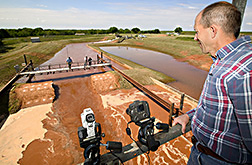This page has been archived and is being provided for reference purposes only. The page is no longer being updated, and therefore, links on the page may be invalid.
|
Read the magazine story to find out more. |
|
|
Maintaining the Safety of Earthen Dams
By Luis PonsAugust 4, 2005
Agricultural Research Service (ARS) scientists have gone the extra mile--plus a few thousand actual ones--to assure the accuracy of computer models that help them understand and predict the failure of earthen dams.
Greg Hanson, a hydraulic engineer in the ARS Hydraulic Engineering Research Unit (HERU) in Stillwater, Okla., recently traveled to England and Norway to assist in dam-breach tests and acquire real-time data useful in verifying computer-derived results.
He assisted in seven of 23 small-scale tests conducted in Wallingford, England, and in one of seven large-scale tests in Mo I Rana, Norway. These tests were primarily funded by the European Union and the Research Council of Norway.
The trips were part of research by Stillwater scientists on the phenomenon of overtopping, which causes about 35 percent of all U.S. dam failures. Overtopping, which occurs when water overflows a dam, can lead to embankment erosion and eventual failure of earthen dams. Causes include inadequate or blocked spillways, extreme rainfall and large-scale snowmelt.
Hanson and fellow hydraulic engineer Darrel Temple lead efforts at HERU to develop and use computer models and research flumes to determine in advance how embankments will perform if they do overtop. Their latest work involves the SIMplified Breach Analysis (SIMBA) model, and WINDAM (WINdows Dam Analysis Modules).
SIMBA reproduces key features observed in embankment-dam failure tests, dividing the breach process into four stages because more than one type of erosion may be dominant during a given stage. The researchers hope to integrate SIMBA into WINDAM.
Hanson is focused on smaller earthen embankments, many of which are within communities and range in height from a few feet to a couple of hundred feet. Although U.S. dams have an admirable safety record, about 57,000 of the 80,000 dams in the National Dam Inventory have potential to overtop, according to Hanson.
Read more about the research in the August 2005 issue of Agricultural Research magazine.
ARS is the U.S. Department of Agriculture's chief scientific research agency.

